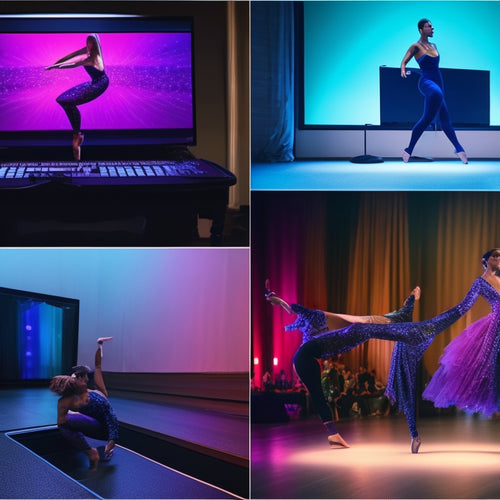
Dance Of America" Installation Honors Black Pioneers
Share
The 'Dance of America' installation is a vibrant tribute to the pioneers of Black dance, highlighting their significant contributions to American dance culture. It celebrates the legacies of pioneers like Chuck Davis, Dianne Walker, and Will Robinson, recognizing their groundbreaking achievements often overlooked in the dance canon. By exploring the intersections of the Harlem Renaissance and the Great Migration, the installation showcases the profound influences on dance evolution, fostering community and cultural expression. As we explore this rich cultural heritage, we uncover the complexities and nuances of Black dance history, shedding light on the significance of preserving these legacies.
Key Takeaways
• The 'Dance of America' installation celebrates Black dance heritage, highlighting pioneers who shaped genres like ballet, jazz, hip-hop, and tap.
• Featured artists include Chuck Davis, Dianne Walker, and Will Robinson, whose groundbreaking contributions are often overlooked.
• The installation honors the legacies of these pioneers, providing an interactive platform for their stories to be told.
• The Harlem Renaissance and Great Migration greatly influenced American dance culture, fostering community and cultural expression.
• The installation aims to preserve Black dance history, ensuring its significance is recognized and appreciated by future generations.
Celebrating Black Dance Heritage
The 'Dance of America' installation stands as a tribute to the rich cultural heritage of Black dance in the United States, highlighting the often-overlooked contributions of pioneers who shaped the evolution of various genres. This installation celebrates Black dance heritage, underscoring its historical significance in shaping the country's cultural landscape.
Through dance education, visitors can explore the complexities of genres like ballet, jazz, hip-hop, and tap, gaining a deeper understanding of their development. By acknowledging the pioneers who paved the way, the installation sheds light on the importance of preserving Black dance history, ensuring that future generations can appreciate the cultural significance of these contributions.
Featured Artists and Their Legacies
Elijah Gibson's 'Dance of America' installation honors a diverse range of Black dance pioneers, including Chuck Davis, Dianne Walker, and Will Robinson, whose groundbreaking contributions have often been overlooked in mainstream dance histories.
These visionary artists have played a significant role in shaping the dance evolution in the United States. The installation sheds light on their overlooked contributions, providing a platform for their legacies to be recognized and celebrated.
Through interactive timelines and archived video footage, visitors can explore the lives and works of these pioneers, gaining a deeper understanding of their impact on the dance world.
Influences on American Dance Culture
Shaping American dance culture, the Harlem Renaissance and the Great Migration exerted profound influences on the evolution of dance in the United States. These movements not only fostered a sense of community and cultural expression but also paved the way for the development of various dance genres.
The Great Migration, which saw millions of African Americans move from the rural South to urban centers, created a fertile ground for the convergence of diverse cultural influences. The Harlem Renaissance, a cultural and intellectual movement, provided a safe space for Black artists to express themselves freely.
The confluence of these movements inspired a new wave of cultural expressions, including dance, which continues to shape American dance culture to this day.
Frequently Asked Questions
What Is the Ideal Age Range for Visitors to the 'Dance of America' Installation?
When considering the ideal age range for visitors, cultural sensitivity and learning threshold are essential. Children under 8 may not grasp the nuances, while teenagers and adults can appreciate the historical context and cultural significance, making 13+ an ideal age range for meaningful engagement.
Are Guided Tours Available for the 'Dance of America' Exhibit?
"Absence of evidence is not evidence of absence." Guided tours are available for the exhibit, offering an immersive experience with audio narration, providing behind-the-scenes insights into the lives and contributions of Black dance pioneers.
Can Visitors Interact With the Archived Video Footage on Display?
Visitors can engage in digital exploration of the archived video footage, fostering immersive experiences through interactive timelines, allowing for in-depth footage exploration and facilitating a deeper understanding of Black dance history.
Will the Installation Feature Live Dance Performances or Only Recorded Footage?
In a fusion of past and present, the installation might incorporate live music and dance performances, blending traditional styles with contemporary flair, but it's unclear if live dance will be featured alongside the archived video footage.
Is the 'Dance of America' Installation a Traveling Exhibit or Stationary?
Considering museum logistics, the 'Dance of America' installation's cultural significance necessitates a stationary exhibit, allowing for a contemplative and immersive experience, rather than a traveling exhibit that might compromise its impact.
Related Posts
-

Elevate Your Dance Choreography With Top Video Editing Tools
You're just a few clicks away from maximizing your dance choreography potential! With top video editing tools like Ad...
-

7 Formal Dance Dresses for Black-Tie Events
For your next black-tie event, consider these seven stunning formal dance dresses that promise to turn heads. A class...
-

What Are the Essential Performance Clothing Items for Your Next Workout
When it comes to crushing your next workout, the right performance clothing can make all the difference. You'll want ...


